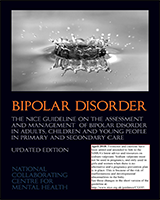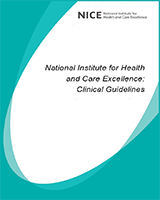All rights reserved. No part of this guideline may be reprinted or reproduced or utilised in any form or by any electronic, mechanical, or other means, now known or hereafter invented, or in any information storage or retrieval system, without permission in writing from the National Collaborating Centre for Mental Health. Enquiries in this regard should be directed to the Centre Administrator: ku.ca.hcyspcr@nimdAHMCCN
NCBI Bookshelf. A service of the National Library of Medicine, National Institutes of Health.
National Collaborating Centre for Mental Health (UK). Bipolar Disorder: The NICE Guideline on the Assessment and Management of Bipolar Disorder in Adults, Children and Young People in Primary and Secondary Care. London: The British Psychological Society and The Royal College of Psychiatrists; 2014 Sep. (NICE Clinical Guidelines, No. 185.)
April 2018: Footnotes and cautions have been added and amended to link to the MHRA's latest advice and resources on sodium valproate. Sodium valproate must not be used in pregnancy, and only used in girls and women when there is no alternative and a pregnancy prevention plan is in place. This is because of the risk of malformations and developmental abnormalities in the baby. November 2017: Footnotes for some recommendations were updated with current UK marketing authorisations and MHRA advice. Links to other guidelines have also been updated. Some research recommendations have been stood down. See these changes in the short version of the guideline.

Bipolar Disorder: The NICE Guideline on the Assessment and Management of Bipolar Disorder in Adults, Children and Young People in Primary and Secondary Care.
Show detailsAbbreviations
- A
acute (mania or depression)
- Ad
acute depression
- CBT
cognitive behavioural therapy
- CI
confidence interval
- FFT
family focused therapy
- GAF
Global Assessment of Functioning scale
- IV
intravariance
- M
maintenance
- M-H
Mantel–Haenszel
- PE
psychoeducation
- SD
standard deviation
- SE
standard error
- TAU
treatment as usual
1.1. Individual Psychological Interventions Compared with Treatment as Usual (TAU)
1.2. Group Psychological Interventions Compared with Treatment as Usual (TAU)
1.3. Family Psychoeducation Compared with TAU
1.4. Family Psychoeducation Compared with an Active Control
1.5. Cognitive Behavioural Therapy (CBT) Compared with an Active Control
1.6. Interpersonal and Social Rhythm Therapy Compared with an Active Control
1.7. Collaborative Care Compared with TAU
1.8. Integrated Group Therapy Compared with Group Drug Counselling
- Abbreviations
- Individual Psychological Interventions Compared with Treatment as Usual (TAU)
- Group Psychological Interventions Compared with Treatment as Usual (TAU)
- Family Psychoeducation Compared with TAU
- Family Psychoeducation Compared with an Active Control
- Cognitive Behavioural Therapy (CBT) Compared with an Active Control
- Interpersonal and Social Rhythm Therapy Compared with an Active Control
- Collaborative Care Compared with TAU
- Integrated Group Therapy Compared with Group Drug Counselling
- Integrated Cognitive and Interpersonal Therapy Compared with Treatment as Usual (TAU)
- Bipolar Disorder: The Management of Bipolar Disorder in Adults, Children and Adolescents, in Primary and Secondary Care (NICE guideline CG38)
- Surveillance report 2017: Bipolar disorder: assessment and management (2014) NICE guideline CG185
- NICE Clinical Guideline 185: Bipolar disorder: assessment and management
- Psychological and Psychosocial Interventions – Forest Plots - Bipolar DisorderPsychological and Psychosocial Interventions – Forest Plots - Bipolar Disorder
- Interventions for Acute Depression – Risk of Bias Tables - Bipolar DisorderInterventions for Acute Depression – Risk of Bias Tables - Bipolar Disorder
- Research Recommendations - Bipolar DisorderResearch Recommendations - Bipolar Disorder
- Interventions for Long-Term Management – Risk of Bias Table - Bipolar DisorderInterventions for Long-Term Management – Risk of Bias Table - Bipolar Disorder
Your browsing activity is empty.
Activity recording is turned off.
See more...





















































































































